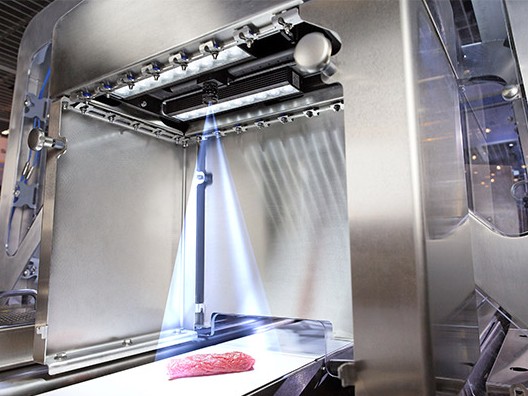
‘Trends in automation’ is a very broad topic. It covers traceability, analysis of big data and machines which are ever-better aligned with one another. Tablets are also becoming increasingly commonplace on the factory floor.
The most important trend is traceability. “Of course, that has a lot to do with the recent food scandals,” says Godfried Mensink, head of automation at equipment manufacturer SFK LEBLANC. “We supply slaughtering and deboning lines and logistics solutions. In the past, it was enough to record the origin of animals at group level, but nowadays the focus has shifted to the individual animal. For instance, it is necessary to register what the animals have been fed and whether they have had any diseases. That data remains linked to the meat throughout the entire production process.”

“Retailers place high demands on traceability”
Another industry professional who regards traceability as an important trend is Roy Meenderink, commercial director at ReflexSystems Nederland (supplier of automation solutions). “Awareness is growing all the time. Whereas manufacturers only used to focus on traceability because they had to, after the scandals involving horsemeat and salmon they are increasingly realising how important it is. Lidl and Aldi Germany require their suppliers to record the country of origin using fTrance. This allocates a code to all ingredients, and data is added to that code during processing. All the data is then merged into a single code which consumers can scan in order to see precisely where the ingredients in a particular product have come from. Aldi and Lidl Germany are currently leading the industry in this area, but I expect other retailers to soon follow suit.” Jacques Jobse, sales manager at CSB-System Benelux, has also noticed that this topic is attracting a lot of attention among his customers. “We can implement very far-reaching traceability,” he explains. “But we also tell customers that it’s not always necessary to register everything down to the finest detail, because that means that you have to keep all batches separate throughout the entire production process. Traceability must remain workable. That’s why we always start by preparing an overview of a company’s risks. They can then decide whether they want batch-based or day-based registration, for example.”
A second key trend is the analysis of big data. “Every system prepares reports, of course,” comments Maarten Cordenier, food solution manager ERP - SAP at Delaware Consulting Netherlands. “But we are seeing that food manufacturers increasingly know which types of information and analysis are important to them. SAP has developed HANA which gives fast access to up-to-date information contained in the ERP system. This enables companies themselves to download and analyse specific data from the system in a user-friendly manner. This new in-memory technology is widely used in the food industry to gain direct insight into aspects such as production costs and logistics processes, and to make well-grounded forecasts for the future.” Another person to mention this trend is Dennis Lucas, director of Provelu. “Many companies work with several different software packages such as for bookkeeping, the logistics processes and employee planning. We have developed dashboards which enable the data from such systems to be analysed. Some companies even include weather data in their dashboard so that they can see precisely how the weather influences the number of orders placed, for instance. Analysing big data is a good way of revealing blind spots, saving costs and identifying opportunities. For example, analysis can offer insight into which employees, machines or items produce the most material waste. And such insights enable the process to be optimised further.”
Cordenier (Delaware) is seeing a growing number of food manufacturers replacing their various software programs – such as for logistics, finance and HR – with a single ERP application to improve the alignment between both office-based and factory-based processes. “The major benefit of this approach is that there is just one truth. Everyone has the same insights and works with the same data. That is more efficient, supports quick decision-making and eliminates mistakes. For example, the results of quality checks in the factory can be directly communicated to the customer. This is especially important in the food industry which often involves fresh products.” Ernst-Jan Huijbers, director of Alewijnse Industrial Automation, agrees that separate systems are increasingly connected. “More and more customers are placing their orders directly in a computer system, for example, which then prepares a logical production plan based on that data. The system will take account of all kinds of factors, such as that it’s best for the production line to start with allergen-free products and that changeovers should be minimised.” Meenderink (ReflexSystems) has noticed a similar trend. “Major retailers place their orders using an EDI system. The data is often used automatically to manage other processes such as the automated procurement of the right raw materials. EDI usage is extending further up the chain: whereas it was previously used only by retailers, nowadays wholesalers are also using it to place orders. Suppliers to smaller companies, such as in the food service sector, are not quite so advanced but they are making progress. They are increasingly setting up a webshop which is also optimised for smartphones. The key advantage is that customers can order online 24 hours a day. Furthermore, sales representatives have to spend less time taking orders and hence have more time to spend on advising customers.”
Vision systems are also high on the list of trends. “Cameras are becoming increasingly advanced and hence more commonplace,” says Robert Ruesen, account manager automation at Multivac. “Cameras allow manufacturers to perform a thorough final inspection, such as to ensure there are no foreign bodies in the seal seam and to check that the label is positioned correctly. Optical character recognition (OCR) even makes it possible to check whether the packaging displays the correct best-before date. This enables rapid identification of any errors.” Mensink (SFK LEBLANC) has noticed the growing use of cameras too. “Every animal is different, so it’s useful for slaughterhouses to be able to take a 3D photo of each animal. That provides enough information for a slaughter robot to open the belly and remove the rectum, for instance.” Mensink says that slaughter robots are able to perform a growing number of tasks, but that not all slaughter activities are robotised. “More tasks will be added in the future.”
'Uniformity makes life easier for production employees'
As another trend, equipment manufacturers mention the fact that customers are increasingly choosing complete solutions. “Machines from the same manufacturer are seamlessly aligned with one another,” explains Ruesen (Multivac). “For instance, we supply a thermoformer for small portion packs combined with our own robotic system to place the packs in a box. Our robotic system can reach well into the cutting mechanism of our packaging machine to retrieve the packs without any loss of efficiency. It isn’t possible to achieve such far-reaching integration between machines and robots from different manufacturers. In addition, we’re noticing that customers increasingly want to manage their equipment centrally, whereby formulations and machine settings are also being stored centrally. It’s easier to do that if the entire line runs on the same control system. All the operator displays on the line have the same design and provide information about the whole line rather than just one part of it. Such uniformity makes life easier for production employees.” Roeland Wasser, owner of Spako, agrees that ever-more customers are opting for total solutions. “Emptying a cooking kettle, for example, is a very labour-intensive process which is why we also supply kettles with a pump unit. The product can then be pumped into a buffer tank or directly into a filling machine.” Additionally, he indicates that standardisation is important to large customers. “We have touchscreen-operated agitator kettles which enable customers to store standard programs including the number of litres of water required to fill the kettle, the temperature, the cooking time and the rotation speed. Small companies often place considerable value on traditions and craftsmanship, so such solutions tend to be more popular among larger clients.”
A further trend is the growth in the use of smartphones and tablets. “In the past, business applications could only be accessed from a fixed work location,” explains Sander Lenskens, sales manager SAP at Delaware. “Nowadays new apps are being released all the time which allow employees to access the system and manage or complete processes remotely using a tablet or smartphone. Examples include approving a production order or purchase invoice, or gaining financial insights. We are seeing such applications becoming increasingly commonplace in manufacturing environments.” Lucas (Provelu) has also identified this trend. “We are continually developing numerous apps so that the data can be entered at source, including with photos if necessary. Rugged smartphones and tablets have become significantly cheaper, and often have robust, waterproof casings. A tablet can deliver clear efficiency gains, especially for quality inspections.”

As a final trend, Huijbers (Alewijnse) mentions cybersecurity. “Companies are becoming more aware of the vulnerability of their systems. Cybercriminals carry out large-scale attacks. For companies with a weak level of security, it’s only a matter of time before cybercriminals breach the defences. Then, they can issue fake invoices, change customer orders and alter the production process. On average, it takes companies 227 days to discover that they have been hacked by cybercriminals. There are technological solutions to improve system security, and it is also a matter of policy. A virus can be transmitted by clicking on an advertisement, or on a USB stick brought in from home. It remains challenging. But if companies have effective cybersecurity measures in place, they reduce their chance of becoming victims of an online attack.”
Source: Machine: ©Multivac, Vrouw:©iStock.com/craftvision; Hacked:@iStock.com/weerapatkiatdumrong;